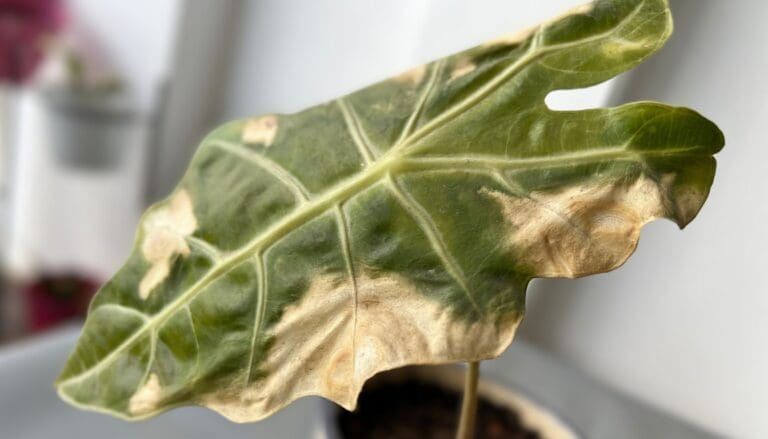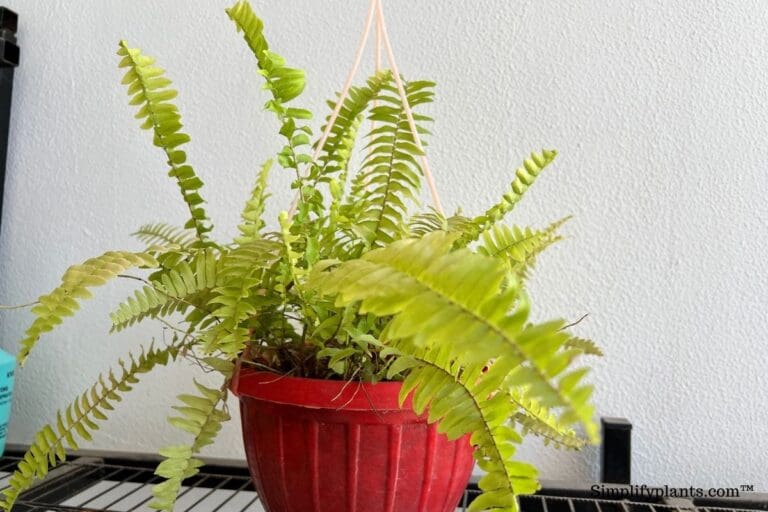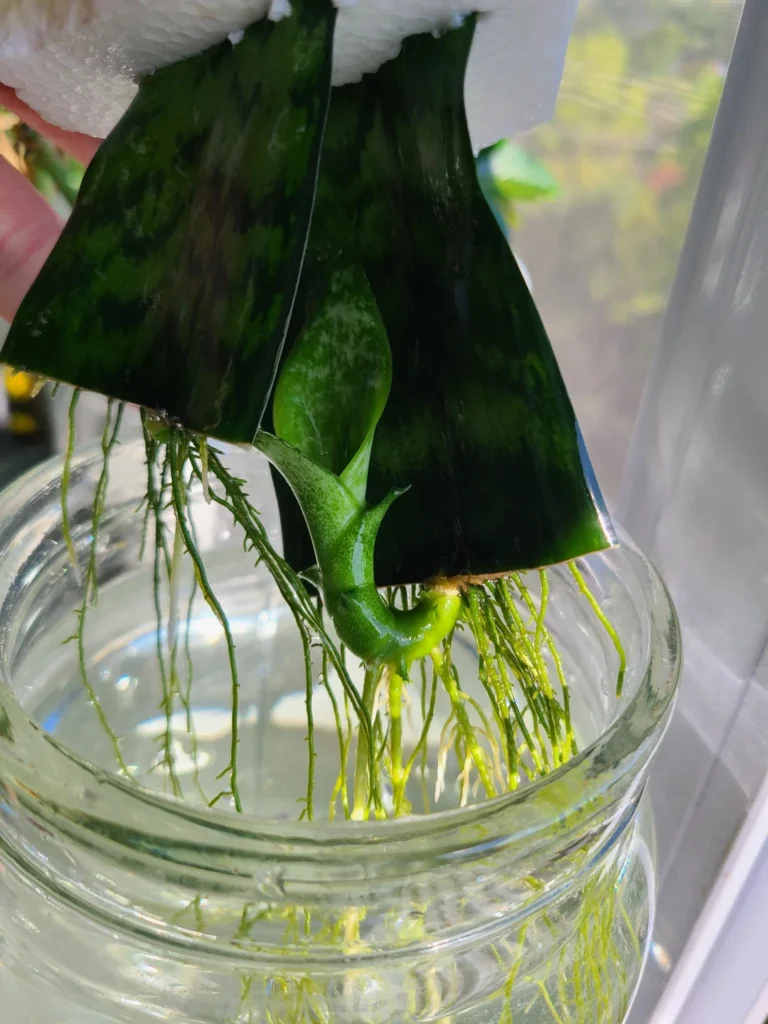How To Care For A Croton Plant? (Ultimate Care Guide)
Croton is a popular foliage plant adapted as a houseplant due to its vibrant leaves. Although Croton does not require a lot of care, it does require some effort from you.
I am bringing everything you need to know about how to care for a croton plant.
Crotons can thrive in full sun to partial shade, depending on the variety of the plant. It demands moist soil and requires regular fertilizer dosing to keep up with the nutrient demand. Temperatures between 65-80°F and humidity range between 50-80% are ideal for this plant.
Let’s understand all the basic requirements of crotons and their problems when anything goes wrong.

Please note: Simplify Plants is reader-supported. Some links in the post are affiliate links and I get a commission from purchases made through links in the post.
Croton overview
Croton is a perennial shrub that hails from Indonesia, Malaysia, and other parts of Southeast Asia.
Crotons can extend up to 10 feet tall in their natural habitat, but they don’t grow as tall when grown as houseplants or in gardens.
Crotons make a beautiful piece of decor for your house with its red, ivory, copper, orange, and green leaves.
Crotons have more than a hundred varieties, and each variety comes with different requirements.
Let’s look at some of the common varieties of crotons grown as houseplants.
1. Yellow Iceton Croton: This species grows 3-4 feet tall and can be grown under full sun and partial shade. The leaves of this species show vibrant yellow variegation. These are grown as both houseplants and in gardens.
2. Superstar Croton: This species has dark green leaves with yellow spots. They can grow 3-5 feet tall and do well in full sun to partial shade.
3. Petra Croton: This croton species produces different shades of orange, green, red, and yellow leaves and prefers bright light. They can grow 4-5 feet tall.
4. Zanzibar Croton: This crouton prefers indirect sunlight for optimum growth. They produce narrow leaves of different shades and grow 3-4 feet tall.
5. Sunny start Croton: Direct morning sunlight and indirect sunlight work best for this species for the rest of the day. They produce light green elliptical leaves and grow 4-6 feet tall.
Is Croton easy to care for?

Crotons require intermediate care.
They are easy to care for, but you must provide warmth and high humidity to these plants.
The light requirements are different for each species, so research and understand the suitable lighting condition for the species you want to grow.
Keep the soil moist but avoid overwatering.
Your Croton will thrive without experiencing any issues with the right growing conditions.
Is Croton indoor or outdoor?
Crotons can be grown both as indoor and outdoor plants.
Many people grow crotons in their gardens because of their colorful leaves.
You can grow crotons outdoors if you live in USDA zones 9-11.
However, it is better to grow Croton indoors in other regions as the harsh winters can damage the plant.
Also read: Can Croton Grow Outside? (Requirements & Care Difference)
Croton care
Croton is a perennial plant that can thrive with the right growing conditions and some care.
However, it can take time for you to understand the plant’s requirements based on external conditions.
It is not unusual for a houseplant to face problems due to unfavorable conditions or improper care.
Don’t get disheartened if you notice any such signs on your Croton.
Instead, try to fix the issues and revive your Croton.
Before we discuss the problems that Croton might face, let’s look at the basic requirements of this plant.
Croton light requirements

Crotons thrive in full sun to partial shade.
The lighting requirement depends on the croton species you own.
You must find a spot in your house that gets the most light throughout the day.
You can keep the Croton in a window that gets 6-8 hours of full sun or bright indirect light.
However, you must remember that Crotons will not tolerate intense heat and sun.
Intense sunlight in the afternoons can cause sunburn, make the soil dry and dehydrate the plant.
Avoid keeping your Croton in low-light conditions, as that will stunt the plant’s growth.
If you don’t get a lot of sunlight in your house, use artificial lights to provide the required light to your Croton.
Also read: What Kind Of Light Does A Croton Need? (Croton Light Requirements )
Croton water requirements
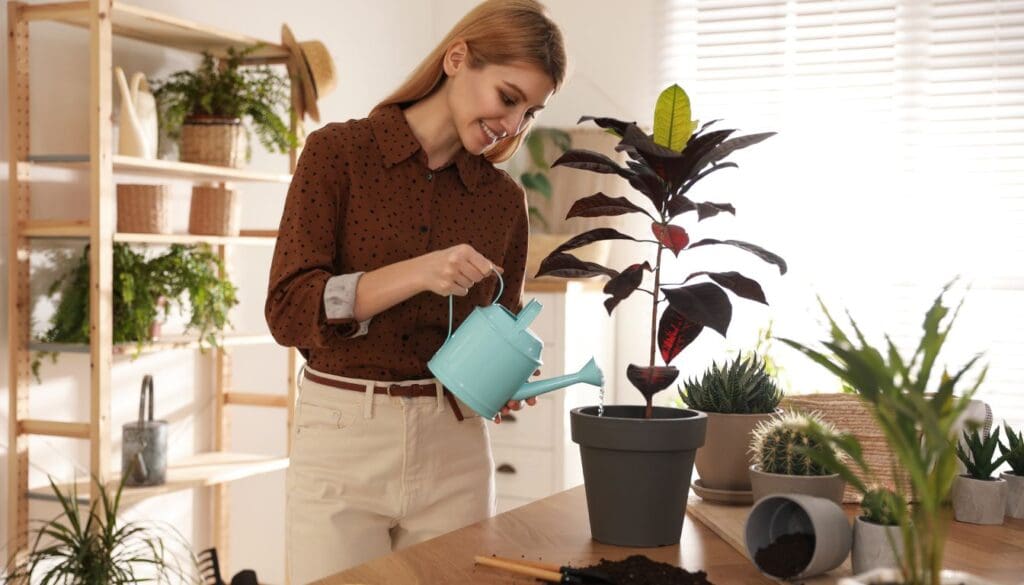
Crotons need a lot of water as they prefer moist soil at all times.
But they disklike standing in water.
So, you must water the Croton after checking the soil’s moisture with a moisture meter or your finger before watering it.
In general, crotons will need water 1-3 times a week if the soil goes dry.
Consider watering your Croton only when the top half-inch of the soil goes dry.
Follow this during the growing season and not in winter.
Although Crotons don’t go dormant in winter, they rest and grow slowly during this time, which is why their water requirement goes down.
Instead of following any routine, it is best to check the Croton plant’s soil moisture and then add water, irrespective of the season.
Also read: How Often To Water Croton Plant? (Watering Schedule+Watering Problems)
Croton soil requirements

Crotons need moist soil to remain happy, but they can’t tolerate soggy soil.
So, you can understand that the soil should support fast drainage so that all the water you provide can move out of the system and not keep the soil soggy.
While preparing the potting soil for your croton, add elements that encourage fast water drainages, such as perlite, peat moss, and compost.
A loose, light-weight, and well-draining soil mix would be ideal for the Crotons.
Here’s a suitable soil recipe for your croton.
You can add:
- 50% of peat moss or coconut fiber
- 25% of perlite
- 10% of sandy soil (You can also use loamy soil as an alternative)
- 5% of lime
- 10% of compost/worm casting
This soil mix will support drainage and keep the roots aerated and retain enough moisture.
Also read: What Kind Of Soil Does A Croton Need? (+Ideal Soil Mix & Requirements)
Croton fertilizer requirement

Crotons prefer being fed with fertilizer once a month during the growing seasons.
The ideal NPK ratio for a Croton is 3:1:2.
Without fertilization, the Croton will show leggy growth, weak stems, smaller leaves, faded leaves, etc.
Fertilizers add the nutrients that the soil loses with time.
If you are looking for some suggestions, you can opt for Charlie compost
or 10:10:10 All-purpose liquid fertilizer as these are suitable for Crotons.
You can also add some compost or organic fertilizer on alternative months.
Also read: What Fertilizer Is Good For Croton? (Best Fertilizer For Croton Plant)
Croton temperature requirement

Crotons are tropical plants, so they require warm conditions.
The ideal temperatures for Crotons lie between 65-80°F.
Although Crotons can tolerate low temperatures of 40°F and high temperatures of 100°F, they will get stressed.
So, you must keep the Croton in a warm room.
Be careful in winter as the temperatures fall during this season.
Keep the Croton in a room with a furnace or a heating source to keep it warm but don’t take the plant too close.
You must also avoid exposing the Croton to temperature fluctuations.
Also read: What Temperature Can Croton Tolerate? (+Ideal Temperature Range)
Croton humidity requirement

Crotons need high humidity.
In their native lands, Crotons are showered with high humidity that keeps them thriving.
The ideal humidity range for Crotons is 50-80%.
You must not let the humidity levels drop below 40%, as dry air does nothing but harm to Crotons.
The ideal way to raise humidity for the Croton is to keep it near a humidifier.
If you don’t own one, mist the plant or group it with other humidity-loving houseplants.
Remember to keep the Croton away from both hot and cold drafts and the direct air of the AC.
Keeping the Croton in the bathroom or basement is another way of providing more humidity than the other rooms.
However, the plant should get the ideal living conditions in these rooms if relocated there.
Also read: Do Crotons Need Misting? (+Maintaining Ideal Humidity)
Croton pruning

Pruning is a necessary part of the care routine for Croton plants.
Although Crotons might not grow very tall as houseplants, they grow bushy.
Without pruning, the Croton will grow uneven and messy.
You can prune the croton any time of the year but the best time to prune is during early spring.
Before pruning, identify the parts that you want to get rid of. These can be:
- Leggy parts
- Overgrown stems
- Diseased stems, roots, and leaves
- Dead foliage
Prune the leaves with a sharp and sterilized pruner and wear gloves to keep your skin protected from the plant’s toxic sap.
Ensure that the cuts are clean and use the healthy cuttings for propagation to get new plants out of the ones you have.
The best thing about Croton is that you can prune it aggressively to promote growth in the plant.
Also read: How To Prune Croton Plant? (When+Step-by-Step Guide)
Croton repotting

First things first, Crotons don’t react well to frequent repotting.
Crotons are not fast-growing plants, so you don’t need to repot them very often.
Crotons require repotting once in 3-5 years when the roots grow too long for the pot.
Try to repot the Croton during early spring or summer and avoid repotting in the winter as the conditions are unfavorable for growth.
Get a bigger pot than the current one and prepare a fresh potting mix before you start repotting the Croton.
Provide the ideal conditions to the plant after repotting it to let it adjust easily.
Check for root rot or any other fungal infections during repotting.
If you are repotting a Croton with decaying roots, remove the damaged ones and apply a fungicide on the healthier ones before repotting.
Also read: When Can You Repot Croton Plant? (+How To Repot)
Croton propagation
Crotons require frequent pruning, and you can use the healthy parts you pruned for propagation instead of throwing them away.
One thing to note is you must not try propagating a Croton with its leaves.
The leaves might grow roots, but they won’t produce entire plants.
But you can use the stems for propagation.
Use a healthy stem of a mature croton plant and put it in water or soil to propagate it.
Ensure that the stems you choose have a few leaves for successful propagation.
You should notice roots coming out within 4-5 weeks of propagation.
Let the roots grow more before finally repotting the young plant to a pot.
There is another way of propagating a Croton, which is called the air layering method.
In this method, you don’t cut an entire stem from the Croton plant but make a small cut, apply rooting hormone, and cover it with wet sphagnum moss and plastic.
Once you notice roots emerging out of the cut, you can cut the stem and plant it in a pot.
Also read: How To Propagate Croton Plant? (A Step-by-Step Guide)
Croton toxicity

Crotons are toxic for both humans and pets.
The sap can irritate the skin and cause dermatitis, a skin rash disease.
Therefore, I recommend using gloves when dealing with the Croton plant.
The vibrant and unique leaves of Croton can attract pets and children.
Therefore, keep Croton away from children or pets as consuming any part of the Croton can cause mild oral and internal issues.
However, ingesting the plant in larger quantities can cause severe issues to your pets where you might need to take them to the vet.
So, you must find a safe place for Croton if you have children and pets in the house.
Also read: Is Croton Plant Pet Friendly? (Cats, Dogs & Other Animals)
Croton pests
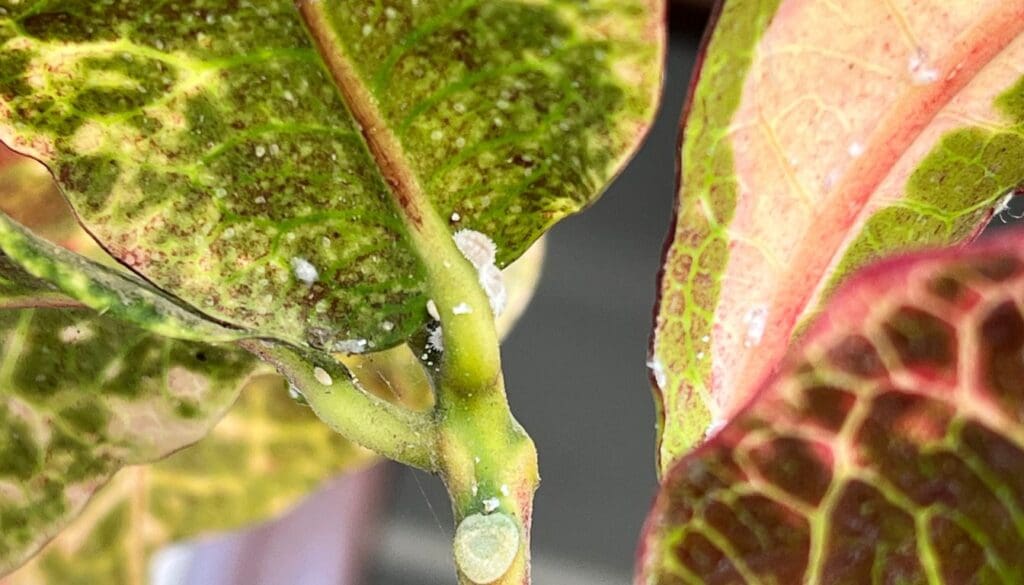
Crotons usually don’t attract pests, but you might find mealybugs, scales, red spider mites, and thrips on these plants.
If you don’t act upon noticing these pests, the infestation can kill the plant as these pests spread fast.
However, pests usually don’t attack a healthy Croton.
So, if Croton has been experiencing unfavorable living conditions, it becomes more prone to a pest attack.
For example, suppose you have been overwatering the Croton, keeping it in a pot with no drainage holes, or using an inappropriate soil mix. In that case, the Croton will remain saturated and attract pests like mealybugs and scales.
On the other hand, if the Croton didn’t receive sufficient water or the soil couldn’t retain enough moisture, it would become dry, which is the ideal condition for red spider mites to thrive.
So, you must provide the ideal growing conditions to your Croton and spray a neem oil solution every month to keep the pests at bay.
If you spot any pest on your Croton, you can use neem oil as the treatment to remove the pests.
Don’t forget to isolate the infected Croton and prune the heavily infested parts.
Also read: How Do I Get Rid Of Bugs In My Croton Plant? (Common Bugs+Fix)
Croton problems
Crotons may develop different problems, but you can save the plant by identifying the early signs and applying the correct steps to fix the problems.
All the problems occur due to something wrong such as wrong watering technique, low light or humidity, insufficient nutrients, etc.
Yellow leaves on Croton
Many Croton plants have yellow leaves, which is natural, but some yellow leaves are signs of issues.
The first reason behind yellow leaves that comes to my mind is overwatering.
Crotons like moist soil and many people can overwater it by mistake to keep the soil moist.
When you overwater the Croton, the soil becomes waterlogged, and the roots remain wet for a long.
These roots start decaying eventually and stop functioning.
When the roots stop functioning, the plant doesn’t get enough water or nutrients, and you start seeing that on the leaves.
The leaves turn yellow due to lack of energy, which is one of the initial signs.
If you can treat Croton when it shows yellow leaves, you can save it from further problems.
You should water your Croton only when the top layers of the soil are dry.
Some other reasons for yellow leaves might be temperature fluctuations, repotting stress, or low light.
Brown leaves on Croton
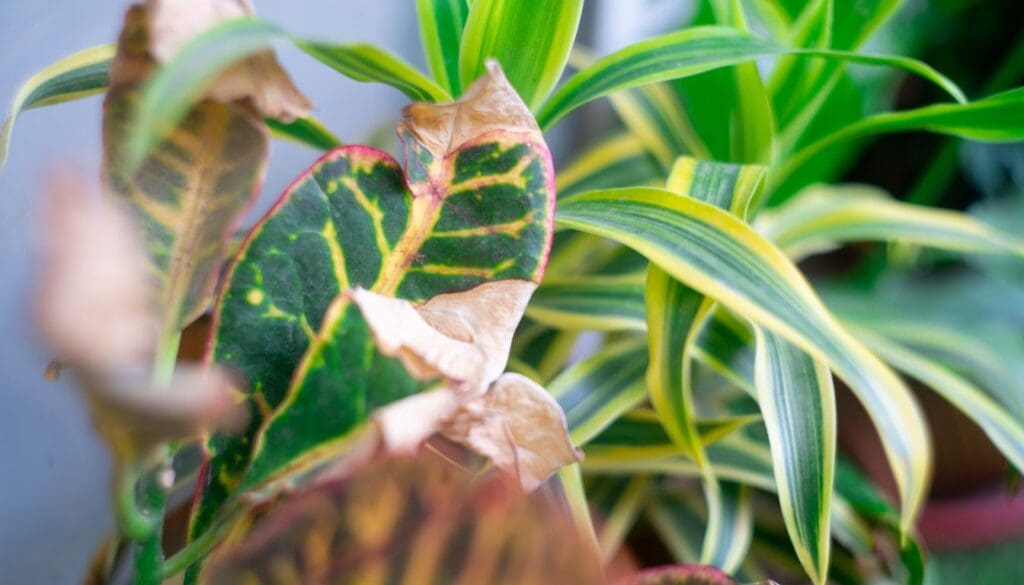
Brown leaves on Crotons are not an initial sign but an urgent call to fix the plant’s issue.
If you expose your Croton to intense afternoon sunlight, the leaves will get scorched and have dry brown spots on them.
You must protect your croton from the intense sunlight by keeping it a few feet away from the window or using curtains.
Low humidity or underwatering can also make the leaves of your Croton brown.
Crotons originate from tropical regions where they get ample humidity.
Without sufficient humidity, the leaves will dry, lose their color and become brown.
Since crotons prefer moist soil, underwatering will stress the plant and dehydrate it.
Brown leaves are nothing but signs of dehydration.
You must ensure that your Croton is getting enough humidity by placing it near a humidifier or misting it with a spray bottle.
Crotons usually require watering 1-3 times a week during their growing season.
If you forget to water the plant, you must maintain a calendar that reminds you to check on your Croton and water it if the soil feels dry.
Also read: Why Are My Croton Leaves Turning Brown? (Causes+How To Fix)
Croton leaves are not staying colorful.

Most croton species have colorful leaves making the plant attractive and ideal for houses.
However, many people complain that the lives of their crotons are not colorful.
The primary reason behind leaves not remaining colorful is low light.
Crotons prefer full sun as their leaves require a lot of light to maintain their colors.
If the plant doesn’t get sufficient light, the leaves will turn pale and lose their color.
Therefore, you must always place Croton in a bright spot that provides 6-8 hours of full sun or indirect bright light.
Low temperatures and lack of fertilization can also make the leaves of your Croton lose their color.
Protect your Croton from low temperatures by keeping it in a warm room.
And fertilize it with a 3:1:2 NPK fertilizer during the growing season, so it gets all the nutrients it needs.
Also read: Why Is My Croton Not Colorful? (Possible Problems+How To Fix)
Drying leaves on Croton

Overfertilization, incorrect watering techniques, low humidity, and sunburn – any of these can be the reason behind drying leaves on your Croton.
Crotons require proper fertilization, especially during their growing seasons, but a heavy dose or wrong frequency can overfertilize the plant, burn the roots, and cause the leaves to dry out.
Keeping the Croton thirsty for too long or not providing enough humidity can also dry the leaves.
On the other hand, exposing the plants to intense sunlight extracts all the moisture from the leaves, leaving them dry.
Also read: Why Are My Croton Leaves Drying? (Possible Problems+Solution)
Curling leaves on Croton
If you don’t water your Croton adequately, the leaves will start to curl.
Crotons require moist soil to remain healthy.
But if you don’t water the plant on time, the soil will go dry, and the Croton will fail to absorb any water or nutrients from it.
In such a scenario, the leaves will start curling to prevent the loss of the remaining moisture in them.
Lack of humidity can also make the leaves of your Croton curl.
Crotons and tropical plants require a lot of humidity, so you must not let the humidity levels drop below 40% if you don’t want to see curling leaves on your Croton.
Also read: Why Are My Croton Leaves Curling? (Possible Causes+Fix)
Leggy growth on Croton

Crotons grow up to 10 feet tall in their native lands, but they don’t grow so tall as houseplants.
However, Crotons grow bushy, and they can grow leggy if you don’t prune them correctly.
So, prune your Croton whenever you notice overgrowth and the plant getting out of shape.
Lack of light might also cause leggy growth on your Croton.
The Croton fails to photosynthesize well without sufficient light and doesn’t get enough energy.
Therefore, the leaves and stems don’t grow healthy and become leggy due to a lack of energy.
Provide sufficient light to your Croton and prune it often to avoid leggy growth.
Also read: Why Is My Croton Leggy? (Possible Causes+How To Fix)
Croton dropping leaves
One serious problem that Croton owners might face is dropping leaves.
There can be many reasons behind the dropping of leaves on crotons.
Both overwatering and underwatering can cause the leaves to drop.
When the Croton doesn’t get enough water, it loses the energy to hold the leaves, which is why they drop.
Whereas, when the roots stop functioning due to excess water, the plant doesn’t get any nutrients or water and thus drops leaves.
Temperature fluctuations are also responsible for the dropping of leaves.
Avoid exposing your Croton to temperature fluctuations and keep it in a warm spot of the house.
Water the plant only when the topsoil goes dry.
Consider checking the soil every few days to understand when the plant needs water.
Also read: Why Is My Croton Dropping Leaves? (Causes+How To Fix)
Droopy leaves on Croton
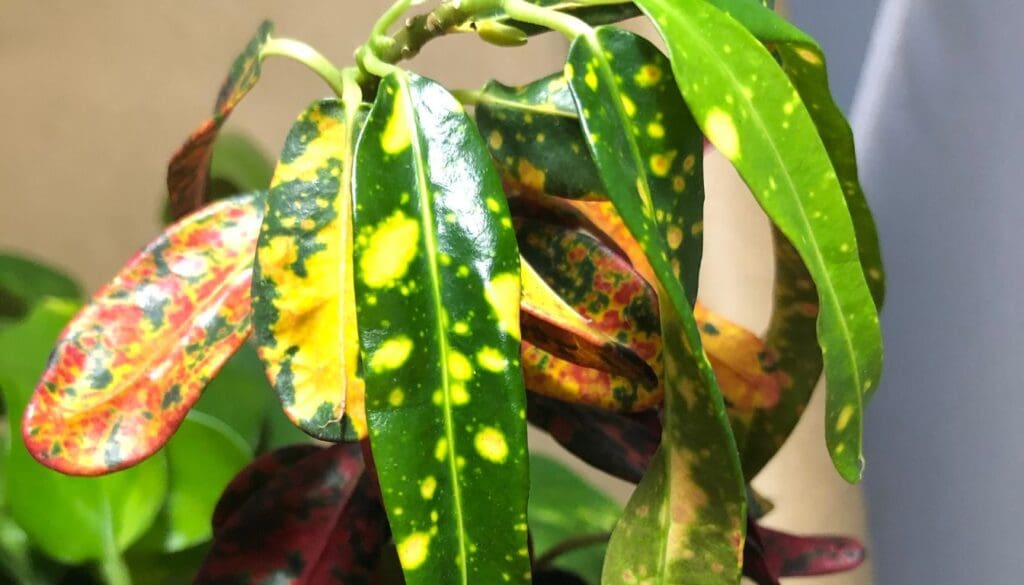
Lack of water is the leading cause of droopy leaves on your Croton.
If you notice droopy leaves, check the soil and add water to it thoroughly if it feels dry.
This should cure the droopiness and make the leaves normal again.
Overwatering can also make the leaves droopy.
If the soil feels wet instead of dry, the reason behind the droopy leaves might be overwatering.
Overwatering is not always caused due to excess water but also due to a poor drainage system.
Always use a pot with drainage holes and add elements like perlite or peat moss to the soil to improve its drainage capacity.
Also read: Why Are My Croton Leaves Drooping? (Possible Causes+Fix)
Root rot in Croton
If you provide excess water to your Croton or don’t provide a proper drainage system, you will notice root rot in the plant.
Root rot is a severe fungal disease that decays the roots and kills the plant if you don’t take any action.
Some signs of root rot are brown leaves, soggy soil, foul smell coming from the soil, soft and brown roots, etc.
If your Croton is undergoing root rot, you must inspect the roots after taking the plant out of the pot and remove the damaged ones with the sterilized pruner.
You must repot the Croton in a new pot with fresh potting mix after spraying fungi side on the healthy roots.
Also read: Root Rot In Croton (Signs, Causes & Fix)
Croton not growing
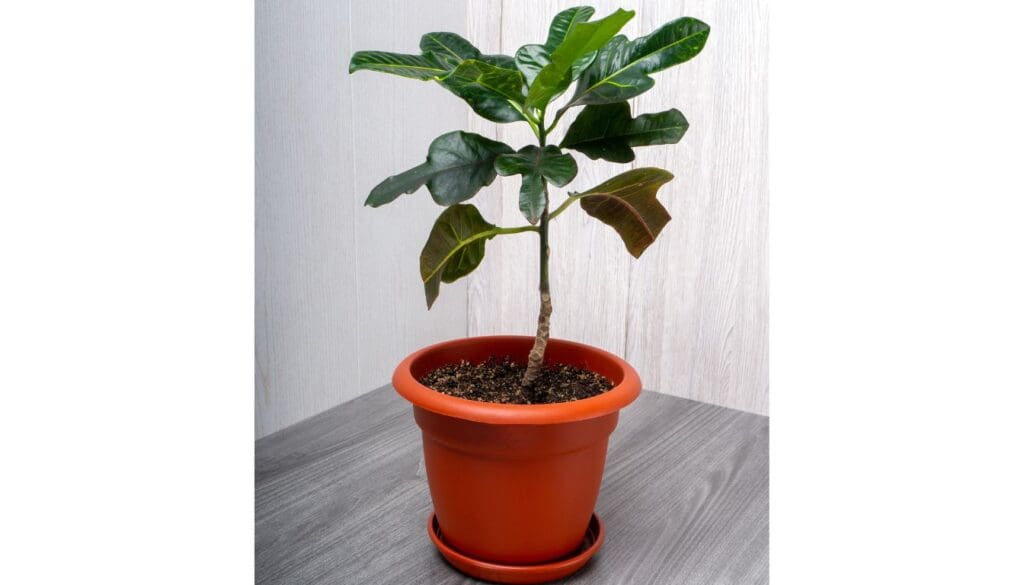
One common problem that Croton owners often face is no growth in their plants.
This happens due to a wrong care routine or unfavorable growing conditions.
Some reasons behind your Croton not growing might be:
- Low light
- Inappropriate watering
- Lack of nutrients
- Wrong potting mix
- Lack of pruning
- Temperature fluctuations
- Lack of humidity
- Pest infestation
Many people suggest pruning your Croton aggressively if it is not growing.
This can encourage Croton to grow again.
Also read: Why Is My Croton Not Growing? (Possible Problems+Solution)
Croton care tips

Here are the basic requirements of Crotons that will help you keep the plant happy and healthy.
| Factor | Care Tips |
|---|---|
| Light | Crotons can thrive in full sun to partial shade but research the species you want to understand its exact requirements. Avoid exposing it to intense sunlight, and don’t keep it in low-light areas. |
| Water | A Croton might require watering 1-3 times a week during the growing season based on how fast the soil is drying out. The idea is to water only after checking the soil and making sure it is dry. |
| Soil | Crotons prefer moist soil, but heavy soil will retain excess moisture, making the soil soggy. Therefore, a loose, light, and well-drained soil mix is best suited for Crotons. |
| Fertilizer | A high Nitrogen fertilizer with an NPK ratio of 3:1:2 would be ideal for Crotons. Fertilize it generously during the growing season as it is a heavy feeder. |
| Temperature | Crotons require warmth at all times. The ideal temperature for Croton is 65-80°F. |
| Humidity | Crotons love humidity and require a lot of humidity to thrive. 50-80% is the ideal range of humidity for these plants. A humidifier is the best and easiest way of providing enough humidity to your Croton. |
| Pruning | Pruning is a must for Crotons as, without it, the plant will grow uneven, messy, and leggy. You can prune the Croton during any time of the year, but early spring is ideal as the plant can recover the stress and grow fast due to the ideal growing conditions. Unlike many other plants, you can prune the Croton aggressively, especially if it is not growing. |
| Repotting | Crotons don’t react well to frequent repotting as they don’t need to be repotted too often. You must repot a Croton only when the roots grow too long for the pot or the plant undergoes any disease like root rot. A Croton requires repotting once in 3-5 years. |
| Propagation | You can use the healthy cuttings you get from pruning for propagation. You can propagate Croton both in soil and water. You can also use the air layering method to propagate the Croton mentioned earlier. However, don’t use a leaf for propagation as leaves of Crotons can’t produce entire plants. Take good care of the propagated cuttings by providing enough moisture and keeping them in a bright spot for successful propagation. |
FAQ
Does Croton need direct sunlight?

Many Croton species require direct sunlight to thrive.
However, some species can’t tolerate direct sunlight, so always research before you conclude what lighting is best suited for your Croton plant.
But protect all Crotons from the intense sunlight, especially during the afternoons, as it can cause sunburn.
Also read: Can Crotons Get Too Much Sun? (Sunburn?)
Is Croton a good indoor plant?
Crotons are great indoor plants as they have unique and vibrant leaves that make the indoor area attractive and alive.
Crotons also clean the air, which is an added benefit of having it in the house.
However, Crotons are toxic, so you must always use gloves while touching the plant and keep it away from the reach of children and pets in the house.
How often should I water Croton?
Crotons require a lot of water as they want moist soil, but you should water it only when the soil is dry.
If you are a beginner, you can check the plant’s soil every day in a week to understand how many times the soil is going dry.
This will give you an idea of how many times you need to check the soil of the Croton in a week.
Every time the top inches of the soil feel dry, you can water your Croton.
Note: The water requirement of your Croton will depend on the external conditions, season, the potting mix, etc., so never forget to check the soil before watering.
Also read: How To Save Overwatered Croton Plant? (Signs, Problems & Solution)
What is the lifespan of a croton plant?
A Croton growing as a houseplant can live as long as 2-4 years.
However, it might even live longer, depending on the care you provide.
Propagating a Croton by taking stem cuttings from it is an excellent way of keeping the plant alive.
Also read: How Fast Do Crotons Grow? (Croton Growth Rate)
Reference: Sciencedirect, Wikipedia, Wikipedia, Britannica, CABI, Academia, University of South Florida, The University of Georgia.
Recommended Garden Supplies
| Product Image | Our Recommended Gardening Supplies | Check Offers! |
|---|---|---|
Top Top
Top
Top
Top
Top
Top
Top
Top | rePotme Houseplant and Tropical Classic Potting Soil Mix | Check Offer On Amazon |
 Top
Top
Top
Top
Top
Top
Top
Top | Espoma Organic Indoor Plant Food | Check Offer On Amazon |
 Top
Top
Top
Top
Top
Top
Top
Top | GooingTop LED Grow Light 6000K Full Spectrum Clip Plant Growing Lamp | Check Offer On Amazon |
 Top
Top
Top
Top
Top
Top
Top
Top | Soil Moisture Meter | Check Offer On Amazon |
 Top
Top
Top
Top
Top
Top
Top
Top | Govee Hygrometer Thermometer, Bluetooth Enabled! | Check Offer On Amazon |
 Top
Top | LEVOIT Humidifiers for Large Room(Best For Plants) | Check Offer On Amazon |
 Top
Top
Top
Top
Top
Top
Top
Top | Upgraded DIY Automatic Drip Irrigation Kit, 15 Potted Houseplants Support | Check Offer On Amazon |
 Top
Top
Top
Top
Top
Top
Top
Top | Stainless Steel Heavy Duty Gardening Tool Set | Check Offer On Amazon |
 Top
Top
Top
Top
Top
Top
Top
Top | Bonide Insecticidal Soap | Check Offer On Amazon |
 Top
Top
Top
Top
Top
Top
Top
Top | Bonide 32 oz Spray Neem Oil for Organic Gardening | Check Offer On Amazon |
 Top
Top
Top
Top
Top
Top
Top
Top | Garden Safe Fungicide | Check Offer On Amazon |


